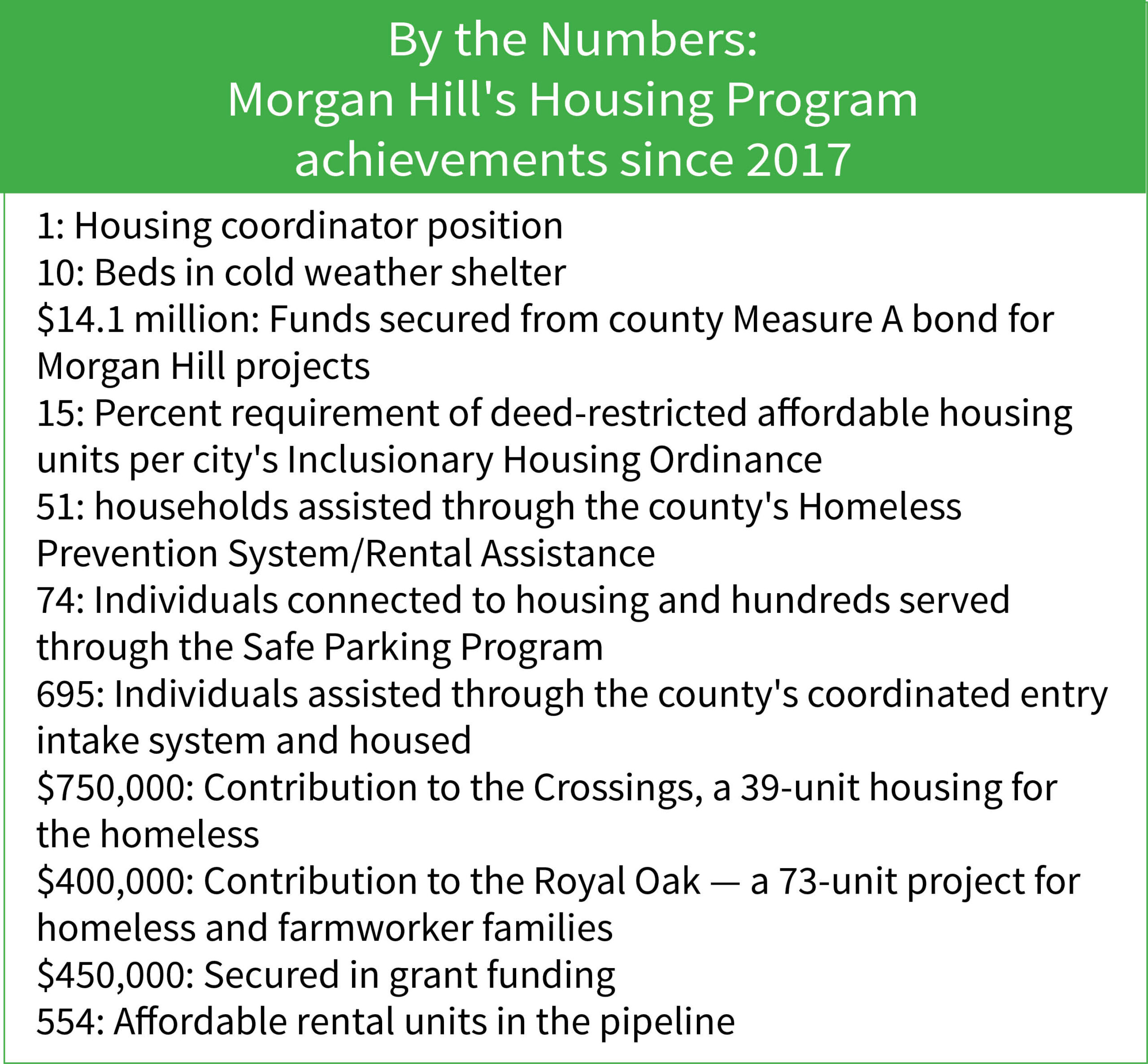Supporting our unhoused residents is rewarding when we help someone get off the streets.
![]()

A family lives in their vehicle on Gilroy Streets several years ago. Photo courtesy Kirti Fatania-Bassendine
By Rebecca Garcia

Rebecca Garcia
 This Thanksgiving season, Morgan Hill has much to be thankful for. In the recent homeless count, the unhoused population in Morgan Hill went from 114 people in 2019 to 60 in 2022—a 47 percent drop. This is the biggest drop by any city in Santa Clara County.
This Thanksgiving season, Morgan Hill has much to be thankful for. In the recent homeless count, the unhoused population in Morgan Hill went from 114 people in 2019 to 60 in 2022—a 47 percent drop. This is the biggest drop by any city in Santa Clara County.
Since 2017, Morgan Hill has helped 695 people (397 adults and 298 children) find a home. Our success is due in great part to the amazing village of churches, non-profits, and service providers that support our small community and help serve our unhoused residents. Our partnerships with the County of Santa Clara, Destination: Home, HouseKeys, St Vincent DePaul, Edward Boss Prado Foundation, Morgan Hill Unified School District, Morgan Hill Bible Church, and Community Christian, to name a few, have allowed us to build an effective program.
Supporting our unhoused residents is hard work and, at times, heartbreaking. But it is also incredibly rewarding when we help someone get off the streets. There are many misperceptions about the unhoused, one of which is that unhoused people choose to be homeless. We recognize some of our unhoused residents experience mental illness and/or may have substance abuse disorders. These situations are only exacerbated by the trauma and challenges of living on the streets. But in our work, we find most people do not want to be homeless. Our unhoused community includes families, children, college students, and others. Sometimes, these individuals are employed and simply cannot afford the high cost of housing.
 For those individuals who live in their cars, the city offers a Safe Parking Program that allows people to temporarily live in their vehicles while receiving case management that helps with their housing search. This program is possible through a partnership with The Morgan Hill Bible Church, the South County Compassion Center, and the Morgan Hill Police Department. The Safe Parking Program serves up to eight families (or 30 people) at any given time and offers showers, laundry, meals, and even connections to jobs. Since 2018, this program has connected 74 individuals with permanent housing.
For those individuals who live in their cars, the city offers a Safe Parking Program that allows people to temporarily live in their vehicles while receiving case management that helps with their housing search. This program is possible through a partnership with The Morgan Hill Bible Church, the South County Compassion Center, and the Morgan Hill Police Department. The Safe Parking Program serves up to eight families (or 30 people) at any given time and offers showers, laundry, meals, and even connections to jobs. Since 2018, this program has connected 74 individuals with permanent housing.
The work centered on homelessness is more of an art than a science. Homelessness can often be described as the “Achilles’ heel” issue of a jurisdiction, but it is possible to make significant progress with action. Through the commitment of the city’s leadership and with support from many community members, our community has influenced the development of a homeless response grounded in compassion, effectiveness, and respect. We are starting to see the fruits of this work.
 In 2017, the city created a Housing Coordinator Position to serve as a liaison to the community and provide housing support. In 2018, when the state eliminated our residential control program that created so many of our affordable housing units, the city created an Inclusionary Housing Ordinance, requiring up to 15 percent affordable housing in all new residential development (including a set-aside of very low-income units). And most recently, this program was revised to allow the city to create a fund that will allow us to develop low and very low-income housing. This shift will help us meet our housing mandate sooner, affording us more local control over future housing projects.
In 2017, the city created a Housing Coordinator Position to serve as a liaison to the community and provide housing support. In 2018, when the state eliminated our residential control program that created so many of our affordable housing units, the city created an Inclusionary Housing Ordinance, requiring up to 15 percent affordable housing in all new residential development (including a set-aside of very low-income units). And most recently, this program was revised to allow the city to create a fund that will allow us to develop low and very low-income housing. This shift will help us meet our housing mandate sooner, affording us more local control over future housing projects.
A recent critical addition to the city team was an unhoused specialist position that provides direct services to and helps our unhoused residents get on the county’s list for housing, creating a bridge to a shelter or permanent housing. This position was created through a $450,000 capacity building grant the city secured with Destination: Home. Connecting our unhoused residents to shelter and services is only one piece of the puzzle. We ground our housing work program on five key pillars:
- Production of New Affordable Housing Units
- Preservation of Existing Affordable Housing Inventory
- Promotion of Housing Programs
- Prevention of Homelessness, and
- Protection of Quality of Life for New and Existing Neighborhoods
Solving homelessness is like making a quilt — patching together as many resources as possible to create a safety blanket that keeps us all warm. On behalf of the city of Morgan Hill and the many service providers, thank you for your support and contributions to our housing-first quilt. We are grateful for your support.
Rebecca Garcia is the city of Morgan Hill Housing Director.






